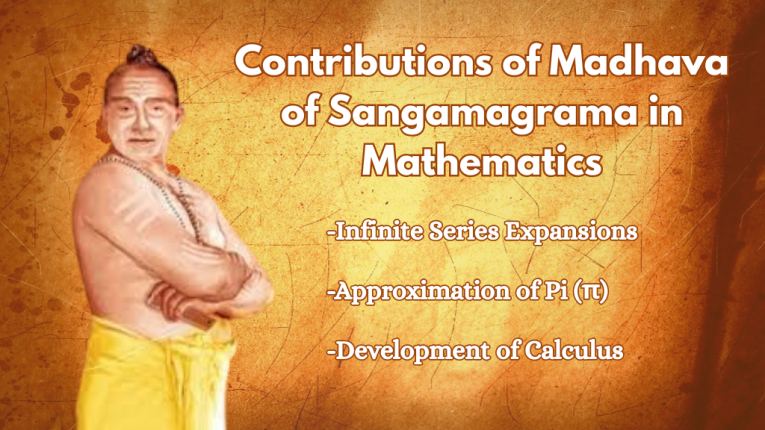When we talk about modern calculus and mathematical analysis, most people name European scientists like Isaac Newton and Leibniz. But very few people know that even hundreds of years before them, there was a great mathematician in India – Madhava of Sangamagrama. He lived in Kerala in the 14th century and laid the foundation of many mathematical principles that became the basis of today’s calculus. That is why he is also called the father of mathematical analysis in India.
Who was Madhava of Sangamagrama?
Madhava of Sangamagrama was born around 1340 AD. Madhava was a great and genius mathematician and astronomer of India, whose work is still considered very important today. He was from a place called Sangamagrama in Kerala, which is now called Irinjalakuda. Although little is known about his personal life, his mathematical legacy continues to influence the world.
The Kerala School of Astronomy and Mathematics was established by Madhava. It was a group of scholars who worked on early mathematical ideas that later became popular in Europe—such as trigonometry, infinite series, and early forms of calculus.
Madhava’s work was based on logic and deep thinking. He gave ideas from which his disciples and future generations could learn a lot. His contribution strengthened the foundation of Indian mathematics.
Contributions of Madhava of Sangamagrama in Mathematics
1. Infinite Series Expansions
Madhava’s groundbreaking insight into mathematics came through his pioneering use of infinite series—well before calculus took shape in Europe. He was the earliest known scholar to represent trigonometric functions like sine, cosine, and arctangent through infinite series expansions. These remarkable formulations laid the foundational stones for what modern mathematics now calls the Taylor series.
This formula is now widely known as the Gregory–Leibniz series, but Madhava had discovered and used it in Kerala almost two centuries before James Gregory and Gottfried Leibniz.
Madhava didn’t just discover these series—he also added special correction terms to make them more accurate. This kind of mathematical detail was very rare during his time.
2. Approximation of Pi (π)
Madhava performed some of the earliest known accurate calculations of pi (π). He used his infinite series to find values that were accurate to 11 decimal places, a remarkable achievement for his time.
His innovation did not stop there. He improved convergence techniques and also introduced correction terms to sharpen the accuracy of infinite series, techniques that resemble what we today call error analysis.
3. Development of Calculus
Although Newton and Leibniz are credited with the formalization of calculus, Madhava’s use of series approximations, limits, and derivatives in trigonometric calculations clearly shows that he was working with ideas that later became central to calculus.
He was not only calculating function values, but also approximating areas under curves, a foundational idea in integral calculus.
Kerala School of Mathematics: Madhava's Legacy
Madhava started the Kerala School of Mathematics, which became known for its brilliant discoveries. Later scholars like Nilakanta Somayaji, Jyeshthadeva, and Achyuta Pisharati continued and expanded his work
These thinkers composed important Sanskrit texts which reflected advanced mathematical and astronomical reasoning. Major works include:
Yuktibhasha by Jyeshthadeva – one of the first texts to explain complex mathematical theories using logical proofs.
Tantrasamgraha by Nilakantha – which elaborated on planetary models and trigonometric progressions.
These works highlight the Kerala School’s commitment to mathematical rigour, systematic analysis and evidence-based methods, all characteristic of modern mathematics. Their advances in infinite series, spherical trigonometry and astronomy are now gaining international recognition.
Recognition and Rediscovery
Unfortunately, Madhava’s work remained largely unknown outside India for centuries. It was only in the 20th century that historians of mathematics began to uncover manuscripts and analyze the profound significance of the Kerala school. Western mathematicians were astonished to discover that many “modern” concepts had already been developed independently in India long before they arrived in Europe.
British mathematician George Gheverghese Joseph and Indian scholar C.K. Raju has consistently emphasized Madhava’s and the Kerala School’s contributions, calling for their recognition in the global history of mathematics.
Why Madhava Matters Today
Understanding Madhava’s work is not just about celebrating an Indian genius; it is about correcting the historical narrative and recognising the global, multicultural origins of science and mathematics. His story encourages:
- A broader view on the development of calculus
- The inclusion of non-European thinkers in the academic curriculum
- Recognition of India’s contributions to global knowledge systems
Highlights
- Madhava was born: Around 1340 AD, Sangamagrama, Kerala
- Field: Mathematics, Astronomy
- Known for: Infinite series, Pi approximation, elementary calculus concepts
- School: Kerala School of Astronomy and Mathematics
Madhava Mathematics Award
To honour Madhav’s profound impact on the field of mathematics, the Madhav Mathematics Prize and Competition is held every year in India. Here’s a quick look:
Organiser: Department of Mathematics, S.P. College, Pune
Collaboration: Homi Bhabha Centre for Science Education (TIFR)
Objective: To recognize and promote excellence in mathematical problem-solving among undergraduate students
Format: Annual mathematics competition testing in-depth understanding and analytical skills
Prize: Winners receive certificates, recognition and sometimes scholarships or academic opportunities
Objective: To inspire young minds to pursue high-level research in mathematics, following Madhav’s visionary legacy
Also, you can read this:
India’s 10 Most Famous Mathematicians Who Changed the World
Who was Aryabhata? The Father of Indian Mathematics and Astronomy
Who was Brahmagupta? Life and Contributions of the Great Mathematician and Astronomer of India
Who was Bhaskara I? His Life, Works, Contributions to Mathematics and Astronomy
Notable Quotes Attributed to Madhava or His School
Although there are no direct quotations of Madhava in the modern sense, some Sanskrit verses from works associated with the Kerala school of astronomy and mathematics reflect his mathematical ideas. Here are a few:
“Sarvatra sankhyeyaah kriyaphalam avikalpyam syat”
(“Numbers everywhere are countable; the result of operations is obvious.”)
“Yuktih pramanaam ganite” Notable quotes associated with Madhava or his school
Although there are no direct quotations of Madhava in the modern sense, some Sanskrit verses from works associated with the Kerala school of astronomy and mathematics reflect his mathematical ideas. Here are some examples:
“Sarvatra Sankhyeyaah Kriyaphalam Avikalpyam Syat” (“There are numbers everywhere.”)
“Logic and reasoning are the foundation of mathematics.”)
“Anantam Api Sankhyaatmakam Iti Budhyate”(“Through numbers, even the infinite can be understood.”)
These reflect the spirit of Madhava’s analytical approach and his pioneering insights into infinite series and rigorous mathematics.
Conclusion
Madhava of Sangamagrama is known in the history of mathematics as a towering figure whose work anticipated modern mathematical analysis centuries before it was even a reality. As we move forward in the rich history of global mathematics, Madhava’s contributions remind us that genius has no geographical boundaries.
By acknowledging his life and work, we not only honor a true pioneer, but also inspire future generations with the story of a man who changed the world with his intellect – long before the world understood it.
FAQ about Madhava of Sangamagrama
Question 1. Who founded the Kerala school of astronomy and mathematics?
Answer: Madhava of Sangamagrama is recognized as the originator of the Kerala School of Mathematics in the 14th century.
Question 2. Why is Madhava of Sangamagrama famous?
Answer: He is known for his pioneering work in infinite series, pi approximation, and early calculus – centuries before Newton or Leibniz.
Question 3. What did Madhava of Sangamagrama do in the field of trigonometry?
Answer: He introduced infinite series representations for sine, cosine, and arctangent, transforming the way trigonometric functions were calculated.
Question 4. Where was Madhava of Sangamagrama born and raised?
Answer: Madhava was born around 1340 AD in Sangamagrama, a place that scholars identify today as present-day Irinjalakuda in Kerala, India.
Question 5. What happened to the writings of Madhava of Sangamagrama?
Answer: His original texts have been lost, but his ideas survive through the works of later scholars such as Jyeshthadeva and Neelakanta Somayaji.




